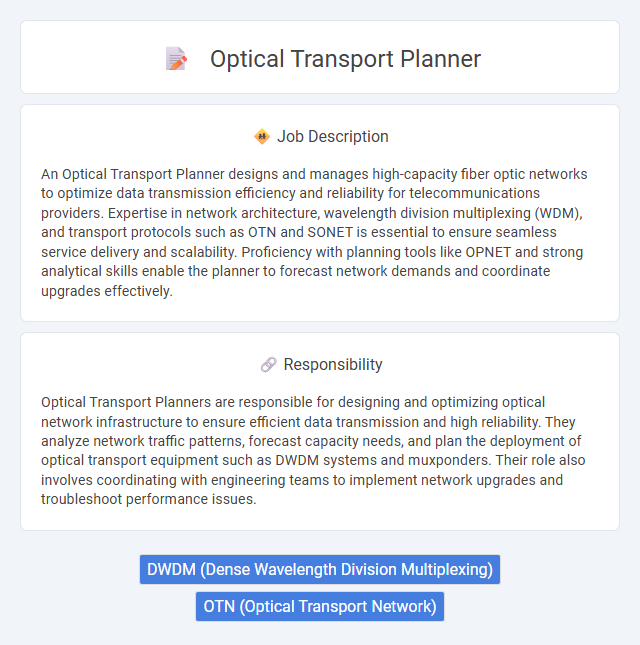
An Optical Transport Planner designs and manages high-capacity fiber optic networks to optimize data transmission efficiency and reliability for telecommunications providers. Expertise in network architecture, wavelength division multiplexing (WDM), and transport protocols such as OTN and SONET is essential to ensure seamless service delivery and scalability. Proficiency with planning tools like OPNET and strong analytical skills enable the planner to forecast network demands and coordinate upgrades effectively.
Individuals with strong analytical skills and a keen interest in telecommunications are likely to thrive as Optical Transport Planners. Candidates who enjoy problem-solving, working with complex data, and coordinating network infrastructure may find this role well-suited to their strengths. Those who prefer routine tasks or minimal collaboration might struggle to meet the demands of this dynamic and detail-oriented position.
Qualification
An Optical Transport Planner requires expertise in network design, data transmission protocols, and optical fiber technologies such as DWDM and OTN. Proficiency in tools like Cisco Transport Controller and experience with capacity planning, route optimization, and maintenance scheduling are essential. Strong skills in analyzing network performance metrics alongside knowledge of industry standards ensure efficient and scalable optical transport network infrastructures.
Responsibility
Optical Transport Planners are responsible for designing and optimizing optical network infrastructure to ensure efficient data transmission and high reliability. They analyze network traffic patterns, forecast capacity needs, and plan the deployment of optical transport equipment such as DWDM systems and muxponders. Their role also involves coordinating with engineering teams to implement network upgrades and troubleshoot performance issues.
Benefit
Optical Transport Planner roles likely offer the benefit of enhancing expertise in managing high-capacity optical networks, which are critical for supporting robust telecommunications infrastructure. Professionals in this position probably gain exposure to advanced technologies and strategic network planning, improving their problem-solving and project management skills. The role may also provide opportunities for career growth within the telecommunications sector due to increasing demand for efficient optical transport solutions.
Challenge
Optical Transport Planner roles likely involve navigating complex network demands and evolving technology standards, presenting continuous challenges in optimizing data flow and infrastructure. The position probably requires adapting to unpredictable traffic patterns and coordinating with multiple teams to ensure seamless optical transport solutions. Managing resource allocation efficiently under tight timelines might also be a frequent obstacle faced in this job.
Career Advancement
The Optical Transport Planner role involves designing and optimizing high-capacity optical networks critical for telecommunications infrastructure growth. Mastery in network planning tools and understanding of DWDM systems significantly enhance career prospects, opening pathways to senior engineering or network architecture positions. Continuous skills development in emerging optical technologies and project management accelerates advancement opportunities within global telecom organizations.
Key Terms
DWDM (Dense Wavelength Division Multiplexing)
Optical Transport Planners specializing in Dense Wavelength Division Multiplexing (DWDM) design and optimize high-capacity fiber optic networks to maximize bandwidth and minimize latency for data transport. They analyze system requirements, coordinate wavelength allocation, and ensure seamless integration of multiplexing components such as optical amplifiers and transponders to enhance network scalability and resilience. Expertise in DWDM technology drives efficient planning of optical channels, supporting large-scale telecommunications infrastructure and data center interconnectivity.
OTN (Optical Transport Network)
The Optical Transport Planner specializes in designing and optimizing Optical Transport Network (OTN) infrastructures to ensure high-capacity, low-latency data transmission across fiber optic networks. Key responsibilities include capacity planning, wavelength assignment, and routing to maximize network efficiency and support scalable service delivery. Expertise in OTN protocols, multiplexing techniques, and optical layer management is essential for maintaining resilient and cost-effective transport solutions.
 kuljobs.com
kuljobs.com